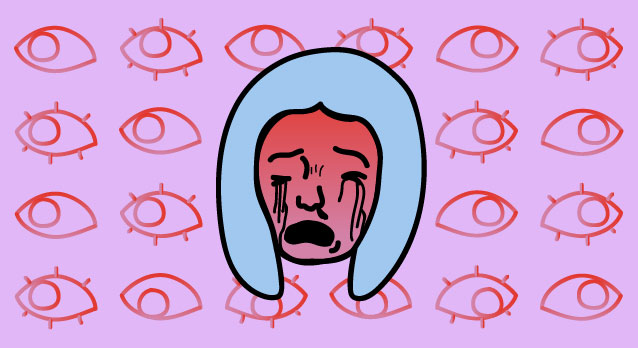Ugly Crying is Empowering
The other day I was crying and a thought occurred to me. While I covered my face with my hair in embarrassment as I was walking back from class, I noticed that my reasons for trying to hide my tears were disturbing. Not only did I not want other people to notice that I was sad, I also didn’t want people to see me because I was. . . ugly crying.
If you’re familiar with the term, then you’ll know that I’m talking about those moments when you full out sob, your face turns red, your mascara runs down your face, and snot runs out of your nose (yes, I said it). Most people would understand and share my reaction to hide my face in shame during my bout of ugly crying. But why? Why is it embarrassing to not cry in a pretty manner? Why is it humiliating to experience a human emotion that most therapists and studies consider healthy ? Why did self-conscious thoughts on my appearance intrude on my moment of catharsis? Why did I care about the people who were looking at me, and why did I automatically believe that they would think less of me?
It turns out that all of these questions can be answered. Some can even be answered by looking at one of the most popular phrases about “regular,” or non-ugly, crying. The phrase “grown ups don’t cry” categorizes even crying as a childish act and leads adults to feel ashamed when they express their sadness. Strict gender roles cause men to actively suppress their tears after adolescence, even though boys typically express a wider range of emotions during infanthood. Interestingly, people often view men more sympathetically than women who cry, believing that women who cry are being manipulative, histrionic, and irrational. Therefore, women feel the pressure to not cry for fear that others might perceive them as weak.
But the problem is, crying is essential for health. Crying removes toxins, lubricates the eyes, kills bacteria, and often leads to an elevated mood afterwards. Crying is a necessary function that is one of our body’s greatest evolutionary tools in communication; when people witness another person crying, they actually can empathize more with that person, which leads to a better sense of community. On the other hand, suppressing tears often leads to higher stress levels, lower levels of health, and can lead to more negative emotions.
While people often avoid crying in public because of the fear of not living up to societal ideas about adult behavior, women also experience “self-objectification,” which refers to the internalization of the idea that our bodies are objects to improve upon instead of tools to master our environments. Self-objectification is basically internalized misogyny. I, a self-proclaimed feminist, fell victim to this internalized misogyny in that moment where I felt ashamed because I was ugly crying. And the truth is, self-objectification is a trap that almost all women fall into because we are taught from a young age that we are supposed to be beautiful and passive.
Ugly crying violates both of these expectations, which is why I felt so uncomfortable expressing myself in such an open, vulnerable way. I reacted to my situation instead of remaining passive and demure, and in the process made myself uglier. Instead of pasting a smile on my face like a docile, beautiful woman, I let go of those self-conscious thoughts, choosing to let myself feel the full release of crying, even at the expense of my “prettiness.” In that moment, I allowed myself to disrupt the norms and to dismiss the values of the patriarchal system.
And that, as my FEM colleague Katherene Quiteno would say, is why ugly crying is so empowering: it’s stress relief and a finger to the patriarchy all at once.





